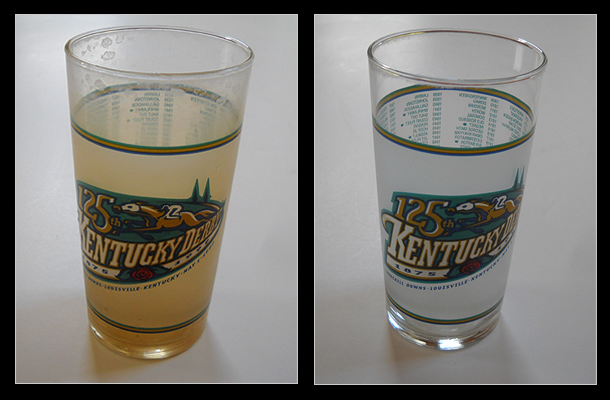Another horse owner questions role of iron in laminitis

This drinking glass shows a three-month buildup of iron from the well water. CLR removes the iron, and the glass looks clear for a few days before the process starts over again.
I have two reasons to revisit the topic of iron and laminitis.
One is an email I received Nov. 26, 2012, from a woman whose 6-year-old mare has been suffering from laminitis since February 2011. The mare was on supplements for a long time, including expensive laminitis supplements, and she still was chronically lame. A month ago, the owner went against conventional wisdom and turned the mare out on a 100-acre pasture with a stream running through it. The horse is now sound and bucking and playing like a foal. Needless to say, the owner has been pleasantly surprised. She’s investigating if the culprit may have been her well water, since the mare is now drinking exclusively from the stream. The owner describes her well water as I would mine: It turns everything orange and tastes bad.
The owner asked me about testing her mare for iron overload.
I suggested she do what I failed to do: a serum ferritin test.
I had Robin Hood tested for iron overload on Oct. 12, 2012, but I believe I asked for the wrong test. I did a serum iron test, which tested the amount of iron currently in Robin’s blood. A local zoo did the test. Robin’s serum iron level is 2.9, with normal being up to 2.6 and the toxic level being 4.6. These numbers are specific to the zoo’s lab. I can’t compare these numbers to the results of other labs.
At any rate, it would be more productive to know the amount of iron stored in Robin’s organs, and this requires a serum ferritin test, which is on our to-do list.
According to veterinarian and author Eleanor Kellon, the higher the serum ferritin, the more iron is stored in the body tissues. Primary storage sites are the liver and the spleen. Kellon says some horses are so heavily loaded with iron that their livers are found to be black on postmortem examinations.
When I first brought up iron overload as a possible cause of my horses’ problems, one prominent laminitis researcher told me iron was studied as a possible cause of laminitis and failed to produce laminitis in study subjects.
However, the human world is completely on board with iron being linked to diabetes. I’ve been hearing this from journalism friends with good sources, but I’m also seeing it in clinical research, which leads me to the second reason I’m revisiting this topic. I just stumbled over a study published September 10, 2012, in the Journal of Clinical Investigation that leads off with the sentence: “Iron overload is associated with increased diabetes risk.”
The study notes that other recent studies have found a negative correlation between serum ferritin and adiponectin, which is an insulin-sensitizing adipokine (a cell-to-cell signaling protein).
“Negative correlation” always makes my head hurt. Adiponectin would be lower in subjects with high serum ferritin levels.
The study says “the hypothesis that adiponectin links iron and insulin resistance is appealing, as decreased adiponectin levels are associated with obesity and type 2 diabetes and are causally linked with insulin resistance.”
The study suggests that serum ferritin levels could predict the presence or absence of metabolic syndrome in humans and that iron reduction may be a possible treatment for diabetes.
I wonder if the problem with the previous iron research in horses was it tried to overload horses’ iron levels in their bloodstream, whereas the destruction may occur over the long haul through iron buildup in organs. Under this scenario, an iron study would have to go on for a long time, which would be very expensive if it required housing horses for an extensive duration.
My three laminitic mares took two to three years to develop laminitis once living at my farm and drinking my well water.
I walk away from this iron theory from time to time as other things grab my attention, but I always seem to come back. What makes me look elsewhere is the fact that not every foundered horse is on well water.
But a lot of people provide trace mineral blocks for their horses, and many of these blocks are 25 percent iron. And a lot of feed makers are putting iron in the feed, too.
Some horses simply may be more sensitive to iron overload.
And horses that get additional iron in the water may be doomed.